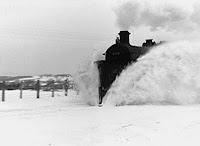Armed with U.S. rifles, women paramilitary volunteers salute as they march past Vietnam's first lady Madame Ngo Dinh Nhu during a military school graduation in Saigon, Feb. 27, 1963. South Vietnam had about 3,000 trained women at the time, with about 1,000 active in the country's military or social service. (AP Photo/Horst Faas)
* From "Vietnam War Almanac" (James H. Willbanks, 2009): Senior White House aide Michael V. Forrestal advises President Kennedy to expect a long and costly war. ... He warns that, in his opinion, Viet Cong recruitment in South Vietnam is effective enough to continue the war even without infiltration from the North. (Forrestal's report was written in late January and apparently presented to Kennedy in early February.)
-- Text of report (from U.S. Department of State): @
* February 24. From The New York Times: A Senate study group warned today the struggle for Vietnamese independence was fast becoming an "American war" that could not be justified by present United States security interests in the area. The four-man panel, headed by Senator Mike Mansfield, the majority leader, called for a "a thorough reassessment of our over-all security requirements on the Southeast Asian mainland" with a view to the orderly curtailment of United States aid programs ... (The) group questioned whether the $5,000,0000,000 spent in aiding Southeast Asia since 1950 had been justified by the results. It was even more doubtful about the wisdom of continuing present policies indefinitely. ... "There is no interest of the United States in Viet Nam which would justify, in present circumstances, the conversion of the war in that country primarily into an American war, to be fought primarily with American lives."
* Summary of report (from U.S. Department of State): @
* Text of report (from Vietnam Center and Archive, Texas Tech University): @
* February 25. From United Press International: The United States has decided to permit its soldiers to shoot first in the Vietnamese guerrilla war without waiting to be fired on by the Communists, it was reported today. The move is aimed at checking the growing U.S. casualty rate in the undeclared jungle war, according to informed sources. Another young American died yesterday. A young machine gunner was killed when two U.S. Army H-21 helicopters were downed by Communist Viet Cong ground fire. The machine gunner, a private first class, was not indentified. His death brought to 52 the number of Americans killed in combat since the United States began its military buildup in South Vietnam in 1961. Informed military sources said the new "rules of engagement" will permit the U.S. Army's new HU-1 gas turbine helicopters to open fire on "positively identified" guerrillas without waiting to be fired on first as heretofore.
-- Memorandum from the Joint Chiefs of Staff to the Secretary of Defense (dated February 16; from U.S. Department of State): @











